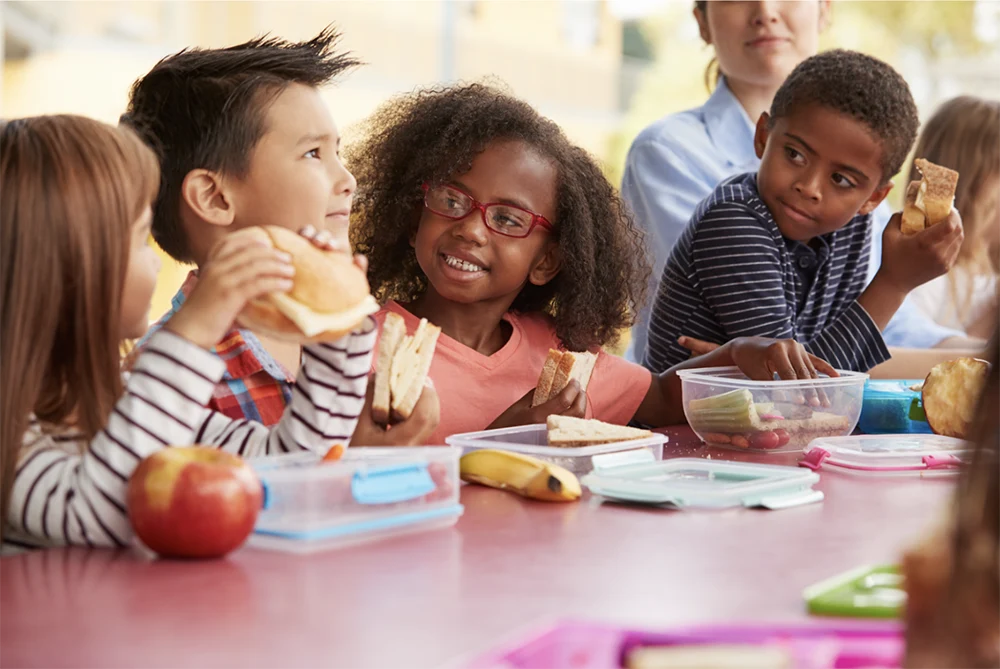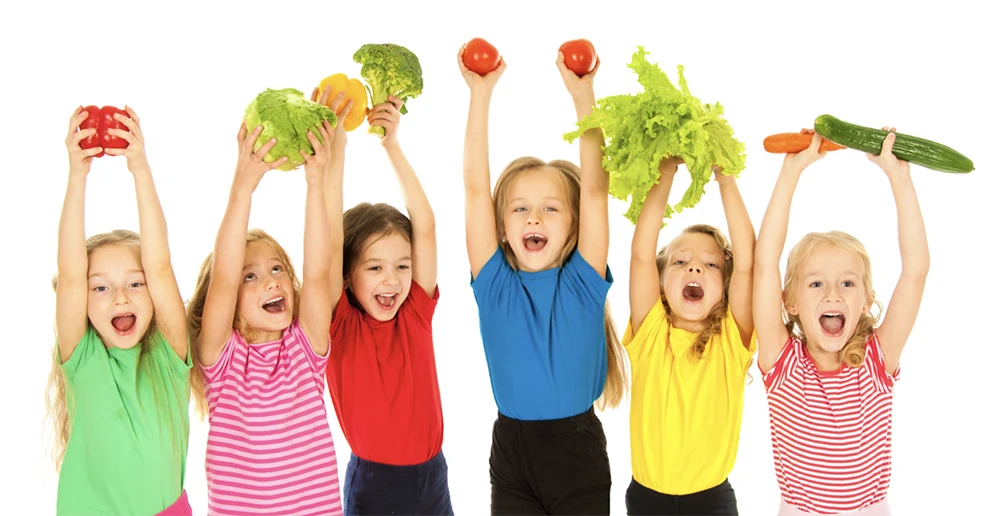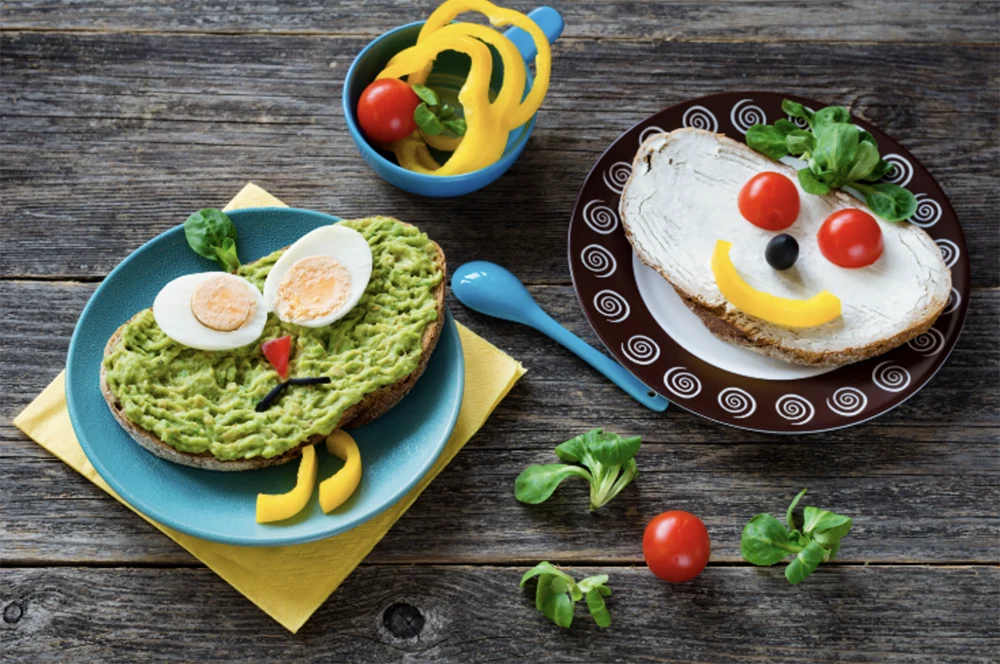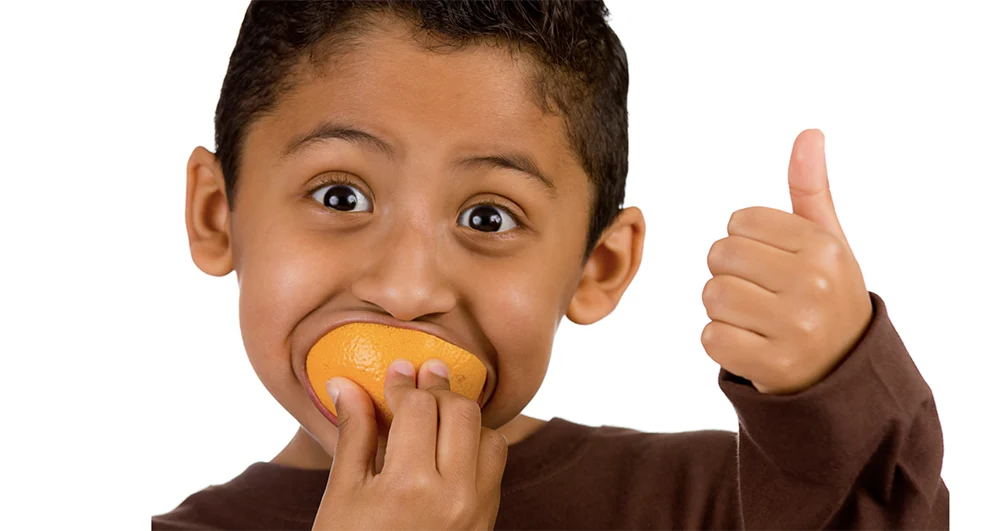You Are What You Eat
Examining Nutrition Through Literature
Introduction | Background Knowledge | Activities | Extensions | Standards

Introduction
Nutrition plays a huge role in education. Early nutritional choices impact a child’s immunity, brain development, and cognitive functioning. As children grow into the school-aged years, nutrition continues to be important to academic success. Well-balanced and healthy nutritional choices support growth and development and set up successful patterns into adulthood.

Background Knowledge
The United States Department of Agriculture issued its first nutritional guidelines in a Farmer's Bulletin in 1894 with recommendations for men. Caroline Hunt, a nutritionist, gave the first recommendations for children in 1916. The guidelines have changed multiple times over the years. During the Great Depression, the USDA suggested food plans for four different income levels to help people plan meals and shop for food. Suggestions were modified during World War II to reflect rationing restrictions. From the 1950s through the 1970s, the “Basic Four” was promoted as necessary for a healthy lifestyle. As science progressed, more people began to understand that basic nutrients did not constitute a healthy meal and that many food choices were contributing to chronic illnesses. The 1970s, 1980s, and 1990s focused on reducing fat consumption, cholesterol, and sodium to combat heart disease. The Food Pyramid emerged as the model for healthy living. In 2005, the Food Pyramid was revised to include physical activity.
The United States Department of Agriculture introduced MyPlate in 2011 to replace the food pyramid model of healthy eating. MyPlate is an easy visual representation of the five food groups and the approximate portions necessary for a healthy diet. The MyPlate visual suggests half of a plate should be comprised of fruits and vegetables. The USDA recommends whole fruits and a variety of vegetables. Grains contain a little more than half the remaining space on the plate, focusing on whole grains. Finally, proteins represent about a third of the plate. The focus for protein should be on lean options that are lower in fat. Finally, low-fat dairy options round out the MyPlate graphic. The USDA also provides portion tables for each food group, giving daily allowances by gender and age.
As First Lady of the United States, Michelle Obama championed the Let’s Move Initiative with President Obama's Task Force on Childhood Obesity. One major focus of this initiative was revising school meal standards to make school lunches healthier. Many children eat half of their daily calories at school; for some, school meals are the only food they eat daily. The initiative brought more whole grains, fruits and vegetables, and less sodium into school lunches.

ACTIVITIES
Start with Literature
Begin with I Will Never Not Eat a Tomato by Lauren Child. (ISBN 9780763621803). Featuring brother and sister, Charlie and Lola, from a TV show aired from 2005-2008, big brother Charlie tries to convince his picky-eating sister to try new things!
Other Options for Literature:
- The Little Pea by Amy Krause Rosenthal (ISBN 9780811846585)
- Gregory, the Terrible Eater by Mitchell Sharmat (ISBN 9780545129312)
- The Adventures of Junk Food Dude by Robin Openshaw (ISBN 0983111308)
- The Very Hungry Caterpillar by Eric Carle (ISBN 9780399226908)
- Healthy Plates: Eating Healthy by Valerie Bodden (ISBN 9781628321074)
- Try It! How Frieda Caplan Changed the Way We Eat by Mara Rockliff (ISBN 978-1534460072)
Gather Information
- Choosemyplate.gov - (TeachersFirst review) With resources for children from preschool to high school, this website is the USDA’s official resource for healthy eating. Students can explore the games and videos to learn about healthy eating. There is also a tab for resources for parents and teachers.
- My Plate Match Game - (TeachersFirst review) From the Dairy Council of California, this interactive game can investigate the different food groups and identify foods that belong in each group. This can be a springboard into more thorough research.
- Scour the nonfiction section of the school or public library and bring in as many resources about healthy eating as possible. The more pictures, the better! Try cookbooks! Students can look through the books to find recipes with lists of ingredients. Some cookbooks even have nutritional information. (Check 641 in your library’s nonfiction section!)
- Harvard's Nutrition Source - (TeachersFirst review) Harvard has created a kid-friendly guide to eating healthy. Students can read the information on the main screen and click links to learn more about each topic.
- Nutrition Education - From the California Department of Education, incorporate one of the many suggestions for nutrition education.
- Invite a nutritionist to come and give a presentation on healthy eating.
Weekly Snack
- There is no better way to encourage healthy eating than by modeling it and showing how healthy eating can be fun! You can tie this activity into literature and connect it to math using a recipe. Adapt the math to lower grades (basic counting) as well as upper grades (measuring and ratios). Students can practice following steps in a sequence, and you can compile a class cookbook using Book Creator (TeachersFirst review). The links below are a small list of examples of how to incorporate a weekly snack into your classroom.
-
Conduct a weekly “Eat a Rainbow” contest. Challenge students to record their consumption of as many colorful fruits and vegetables as they can in a week, then tally the total amount of different colors. Print out this chart from Scan-Harbor for older students to use or this rainbow chart from Such a Mama for younger students.
- Incorporate technology by customizing this Stem: Living Things, Rainbow Food chart from Canva (TeachersFirst review). Use this chart to brainstorm foods of different colors or share colorful fruits and vegetables that students eat each week.
Class Dinner
-
Ask each family to prepare a healthy contribution to a class meal. Students can analyze the recipes and determine if the food is healthy or not healthy. Older students can look at nutritional information to create a healthy menu from the contributions.
- Integrate math by asking students to choose their favorite food shared during the class meal. Use the Data Gif Maker (TeachersFirst review) to easily create and share data in several different formats. Extend learning by asking students to reflect on the data and discuss which graph represents the data most clearly.
Meal Planning
-
Invite students to use the resources listed above in the Gathering Information section to plan a healthy meal. Younger students can use magazine photos or pictures from the Internet to fill their paper plate mobiles showing a day’s worth of meals or just one meal where student groups show various meals and snacks.
- Older students can use recipes and nutritional information to build healthy meals, presenting them in a virtual essay format using Adobe Express for Education (TeachersFirst review).
- A collaborative activity for a small group of students would be to use restaurant menus where students would put together healthy meal plans when not eating at home; students could use Flip (TeachersFirst review) to record themselves with the menus as they talked about their choices.
Do an Experiment
- Set up a good, old-fashioned science experiment. In upper grades, students can run the experiment independently and use the science investigation skills they learned in isolation. Younger students can focus on observation. Have a junk food day. Start with breakfast and have pizza for lunch. Splurge with some soda and cookies for snacks. Ask students how they feel throughout the day and record the results. Ask them to do something physical (run to the fence or do 25 jumping jacks), and then ask them how they feel. Time them doing the task. The next day, repeat with healthy foods. Repeat the tasks and ask them how they feel. Record the results and then discuss them. A good follow-up, or even instructional set, is reading The Adventures of Junk Food Dude by Robin Openshaw aloud or watching the Reading Rainbow video here.
Show What You Know
- Make a movie tour of the weekly snacks or the classroom feast with voiceovers explaining what the students accomplished. (Try FlexClip - TeachersFirst review or Renderforest - TeachersFirst review if your school does not have tablets with movie-making apps available!)
- My Plate projects - Students can glue pictures to large circles to create a healthy plate to share and display.
- Create a collaborative Google Slides (TeachersFirst review) or a Microsoft PowerPoint Online (TeachersFirst review) presentation of the process and the product or healthy recipes with images and share them on the class or school website. Free images may be found at Pixabay (TeachersFirst review) and Unsplash (TeachersFirst review).
- Create a mural of family-style dining depicting healthy dining. Add a short paragraph to tell the ingredients in each dish and why the dish is healthy.
- Make a digital reflection presentation. Choose a favorite tool such as Animoto (TeachersFirst review), Adobe Express for Education (TeachersFirst review), or Slideful - TeachersFirst review.
- Display data from the experiment in a personal reflection showing a side-by-side comparison. Two great tools to try include - Daytum (TeachersFirst review) and Data GIF Maker (TeachersFirst review).

EXTENSIONS
Four Ways to Extend a Healthy Eating Project
-
Field Trips
- Field trips are a great way to make healthy eating exciting! Visit a local farm to see how the produce gets from farm to table. Do you live near a factory that gives tours? Can you take the students to see how ice cream is made or how donuts are made? Can you visit a dairy farm? Do you have families with backyard chickens? Look around your community to find experiences for your students!
-
Different Parts of the Plant
- Explore how we eat different parts of the plant. This can tie into a lesson on the plant life cycle and plant parts. Check out Tops and Bottoms by Janet Stevens (ISBN 978-0152928513) for a great literature connection.
-
Plant a Garden
- Students can plant a container garden or even contribute to a school-wide garden if they have one. Doing this will give them first-hand experience of how food gets from the farm to the table, and students can eat what they grow.
-
Guest Speakers
- If you cannot take your students to the experts, bring the experts to your students. Call your local 4H chapter or a health and wellness coach. Walk down the hall and collaborate with your school cafeteria.

CORRELATION TO STANDARDS
- AASL National School Library Standards
- Inquire Shared Foundation, Think Domain - Learners display curiosity and initiative by: 1. Formulating questions about a personal interest or a curricular topic. 2. Recalling prior and background knowledge as context for new meaning.
- Inquire Shared Foundation: Create Domain: Learners engage with new knowledge by following a process that includes: 1. Using evidence to investigate questions. 2. Devising and implementing a plan to fill knowledge gaps.
- Inquire Shared Foundation, Share Domain - Learners adapt, communicate, and exchange learning products with others in a cycle that includes: 1. Interacting with content presented by others. 2. Providing constructive feedback. 3. Acting on feedback to improve. 4. Sharing products with an authentic audience.
- Include Shared Foundation, Share Domain - Learners exhibit empathy with and tolerance for diverse ideas by: 1. Engaging in informed conversation and active debate. 2. Contributing to discussions in which multiple viewpoints on a topic are expressed.
- Include Shared Foundation, Grow Domain - Learners demonstrate empathy and equity in knowledge building within the global learning community by: 1. Seeking interactions with a range of learners.
- Collaborate Shared Foundation, Think Domain - Learners identify collaborative opportunities by: 1. Demonstrating their desire to broaden and deepen understandings. 2. Developing new understandings through engagement in a learning group. 3. Deciding to solve problems informed by group interaction.
- Collaborate Shared Foundation, Create Domain - s Learners participate in personal, social, and intellectual networks by: 1. Using a variety of communication tools and resources. 2. Establishing connections with other learners to build on their own prior knowledge and create new knowledge.
- Collaborate Shared Foundation, Grow Domain - Learners actively participate with others in learning situations by: 2. Recognizing learning as a social responsibility.
- Explore Shared Foundation, Think Domain - Learners develop and satisfy personal curiosity by: 1. Reading widely and deeply in multiple formats and writing and creating for a variety of purposes.
- Explore Shared Foundation, Create Domain - Learners construct new knowledge by: 1. Problem solving through cycles of design, implementation, and reflection.
- Explore Shared Foundation, Share Domain - Learners engage with the learning community by: 3. Collaboratively identifying innovative solutions to a challenge or problem.
- Explore Shared Foundation, Grow Domain - Learners develop through experience and reflection by: 1. Iteratively responding to challenges. 2. Recognizing capabilities and skills that can be developed, improved, and expanded. 3. Open-mindedly accepting feedback for positive and constructive growth.
-
ISTE Standards for Students
- Empowered Learner - 1b. Students build networks and customize their learning environments in ways that support the learning process. 1c. Students use technology to seek feedback that informs and improves their practice and to demonstrate their learning in a variety of ways.
- Knowledge Constructor - 3d. Students build knowledge by actively exploring real-world issues and problems, developing ideas and theories, and pursuing answers and solutions.
- Innovative Designer - 4d. Students exhibit a tolerance for ambiguity, perseverance, and the capacity to work with open-ended problems.
- Computational Thinker - 5c Students break problems into component parts, extract key information, and develop descriptive models to understand complex systems or facilitate problem-solving.
- Global Collaborator - 7c. Students contribute constructively to project teams, assuming various roles and responsibilities to work effectively toward a common goal.
